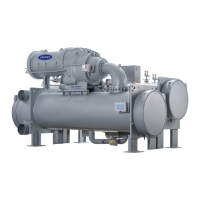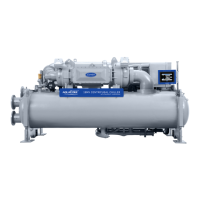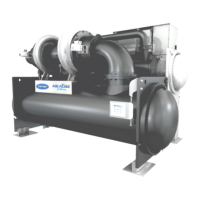3
CONTENTS (cont)
Page
Operator Duties . . . . . . . . . . . . . . . . . . . . . . . . . . . . . . . . . . . .35
Prepare the Chiller for Start-Up . . . . . . . . . . . . . . . . . . . . .35
To Start the Chiller . . . . . . . . . . . . . . . . . . . . . . . . . . . . . . . . .35
Check the Running System. . . . . . . . . . . . . . . . . . . . . . . . .36
To Stop the Chiller . . . . . . . . . . . . . . . . . . . . . . . . . . . . . . . . .36
After Limited Shutdown . . . . . . . . . . . . . . . . . . . . . . . . . . . .36
Preparation for Extended Shutdown. . . . . . . . . . . . . . . .36
After Extended Shutdown . . . . . . . . . . . . . . . . . . . . . . . . . .36
Cold Weather Operation . . . . . . . . . . . . . . . . . . . . . . . . . . . .36
Manual Guide Vane Operation . . . . . . . . . . . . . . . . . . . . . .36
Refrigeration Log. . . . . . . . . . . . . . . . . . . . . . . . . . . . . . . . . . .36
PUMPOUT AND REFRIGERANT
TRANSFER PROCEDURES . . . . . . . . . . . . . . . . . . . . . . .38
Preparation. . . . . . . . . . . . . . . . . . . . . . . . . . . . . . . . . . . . . . . . .38
GENERAL MAINTENANCE . . . . . . . . . . . . . . . . . . . . . . . .41
Refrigerant Properties . . . . . . . . . . . . . . . . . . . . . . . . . . . . . .41
Adding Refrigerant . . . . . . . . . . . . . . . . . . . . . . . . . . . . . . . . .41
Adjusting the Refrigerant Charge. . . . . . . . . . . . . . . . . . 41
Refrigerant Leak Testing . . . . . . . . . . . . . . . . . . . . . . . . . . .41
Leak Rate . . . . . . . . . . . . . . . . . . . . . . . . . . . . . . . . . . . . . . . . . 41
Test After Service, Repair, or Major Leak . . . . . . . . . . .41
Repair the Leak, Retest, and Apply
Standing Vacuum Test . . . . . . . . . . . . . . . . . . . . . . . . . . . . 41
Checking Guide Vanes . . . . . . . . . . . . . . . . . . . . . . . . . . . . .41
Trim Refrigerant Charge . . . . . . . . . . . . . . . . . . . . . . . . . . . .43
WEEKLY MAINTENANCE . . . . . . . . . . . . . . . . . . . . . . . . .43
Check the Refrigerant Lubrication System . . . . . . . . .43
Check for Leaks . . . . . . . . . . . . . . . . . . . . . . . . . . . . . . . . . . . .43
SCHEDULED MAINTENANCE . . . . . . . . . . . . . . . . . . . . .43
Service Ontime . . . . . . . . . . . . . . . . . . . . . . . . . . . . . . . . . . . . .43
Inspect the Control Panel . . . . . . . . . . . . . . . . . . . . . . . . . .43
Inspect the Purge . . . . . . . . . . . . . . . . . . . . . . . . . . . . . . . . . .44
Changing Refrigerant Lubrication Filters . . . . . . . . . . .44
Inspect Refrigerant Float System . . . . . . . . . . . . . . . . . . .44
Inspect Safety Relief Devices and Piping . . . . . . . . . . .44
Compressor Bearing Maintenance . . . . . . . . . . . . . . . . .45
Inspect the Heat Exchanger Tubes
and Flow Devices . . . . . . . . . . . . . . . . . . . . . . . . . . . . . . . . . .45
Water Leaks . . . . . . . . . . . . . . . . . . . . . . . . . . . . . . . . . . . . . . . .45
Water Treatment. . . . . . . . . . . . . . . . . . . . . . . . . . . . . . . . . . . .45
Inspect the VFD . . . . . . . . . . . . . . . . . . . . . . . . . . . . . . . . . . . .45
Recalibrate Pressure Transducers . . . . . . . . . . . . . . . . .46
Recalibrate Temperature Thermistors . . . . . . . . . . . . . .46
Ordering Replacement Chiller Parts . . . . . . . . . . . . . . . .46
Carrier Inhibitor . . . . . . . . . . . . . . . . . . . . . . . . . . . . . . . . . . . .46
TROUBLESHOOTING GUIDE. . . . . . . . . . . . . . . . . . . . . .46
Overview . . . . . . . . . . . . . . . . . . . . . . . . . . . . . . . . . . . . . . . . . . .46
Checking Display Messages. . . . . . . . . . . . . . . . . . . . . . . .46
Checking Temperature Sensors . . . . . . . . . . . . . . . . . . . .46
Checking Pressure Transducers . . . . . . . . . . . . . . . . . . .49
High Altitude Locations . . . . . . . . . . . . . . . . . . . . . . . . . . . .50
Quick Test. . . . . . . . . . . . . . . . . . . . . . . . . . . . . . . . . . . . . . . . . .50
Quick Calibration. . . . . . . . . . . . . . . . . . . . . . . . . . . . . . . . . . .50
Pumpdown/Lockout . . . . . . . . . . . . . . . . . . . . . . . . . . . . . . . .50
Physical Data. . . . . . . . . . . . . . . . . . . . . . . . . . . . . . . . . . . . . . .50
APPENDIX A — PIC5 SCREEN AND MENU
STRUCTURE
. . . . . . . . . . . . . . . . . . . . . . . . . . . . . . . . . . . . . . .71
APPENDIX B — CCN COMMUNICATION
WIRING FOR MULTIPLE CHILLERS (TYPICAL)
. . .75
APPENDIX C — MAINTENANCE SUMMARY
AND LOG SHEETS . . . . . . . . . . . . . . . . . . . . . . . . . . . . . . 76
APPENDIX D — REMOTE CONNECTIVITY
COMMISSIONING . . . . . . . . . . . . . . . . . . . . . . . . . . . . . . . 77
INDEX
. . . . . . . . . . . . . . . . . . . . . . . . . . . . . . . . . . . . . . . . . . . . . .82
INITIAL START-UP CHECKLIST FOR
19DV SEMI-HERMETIC TWO-STAGE
CENTRIFUGAL LIQUID CHILLER
. . . . . . . . . . . . . . CL-1
INTRODUCTION
Prior to initial start-up of the 19DV unit, those involved
in the start-up, operation, and maintenance should be thor-
oughly familiar with these instructions and other necessary
job data. Procedures in this manual are arranged in the se-
quence required for proper chiller start-up and operation.
This book also outlines the control system for those in-
volved in the start-up, operation and maintenance of the unit
before performing start-up procedures. It is intended to be
used in combination with the 19DV Semi-Hermetic Centrif-
ugal Liquid Chillers Controls Operation and Troubleshoot-
ing manual that describes PIC5 controls in detail.
CAUTION
This unit uses a microprocessor control system. Do not
short or jumper between terminations on circuit boards or
modules; control or board failure may result.
Be aware of electrostatic discharge (static electricity) when
handling or making contact with circuit boards or module
connections. Always touch a chassis (grounded) part to
dissipate body electrostatic charge before working inside
control center or use a grounding strap before handling
printed circuit boards.
Use extreme care when handling tools near boards and
when connecting or disconnecting terminal plugs. Circuit
boards can easily be damaged. Always hold boards by the
edges and avoid touching components and connections.
This equipment uses, and can radiate, radio frequency
energy. If not installed and used in accordance with the
instruction manual, it may cause interference to radio
communications. The PIC5 control boards have been
tested and found to comply with the limits for a Class A
computing device pursuant to International Standard in
North America EN 61000-2/3 which are designed to
provide reasonable protection against such interference
when operated in a commercial environment. Operation
of this equipment in a residential area is likely to cause
interference, in which case the user, at his own expense,
will be required to take whatever measures may be
required to correct the interference.
Always store and transport replacement or defective boards
in anti-static shipping bag.
CAUTION
Do NOT punch holes or drill into the top surface of the
control or VFD enclosure for field wiring. Knockouts are
provided for field wiring connections. Drilling holes
through the top of the cabinet can result in a loss of war-
ranty on the starter assembly because of metal particulate
falling on and into electronic components.
CAUTION
PROVIDE MACHINE PROTECTION. Store machine
and starter indoors, protected from construction dirt and
moisture. Inspect under shipping tarps, bags, or crates to be
sure water has not collected during transit. Keep protective
shipping covers in place until machine is ready for
installation. Follow latest Water-Cooled Chillers Long
Term Storage document located in Chiller Builder Library.
CAUTION
WHEN FLUSHING THE WATER SYSTEMS isolate the
chiller from the water circuits to prevent damage to the heat
exchanger tubes.

